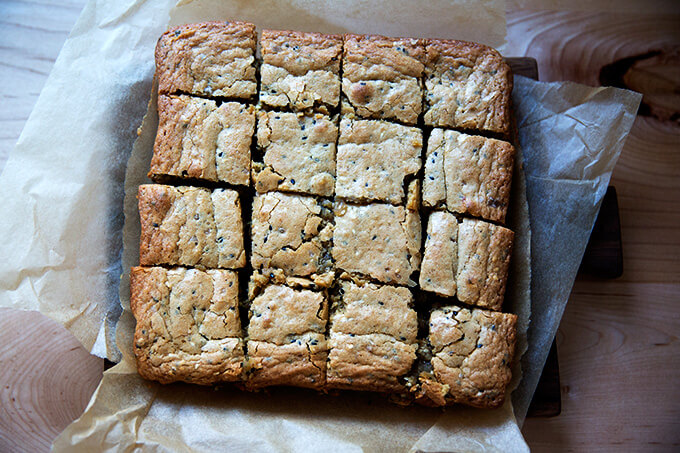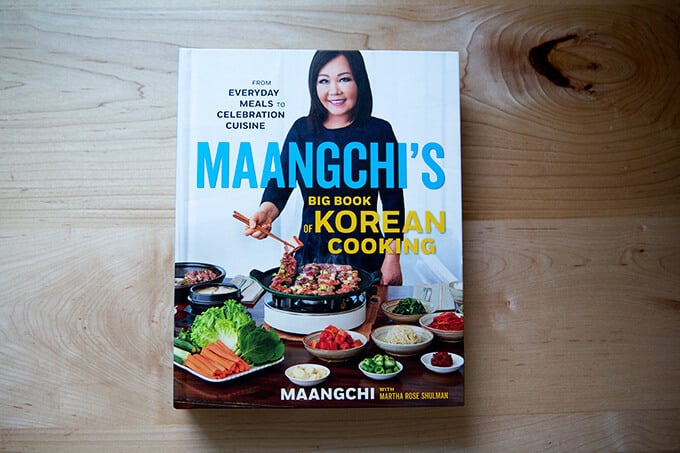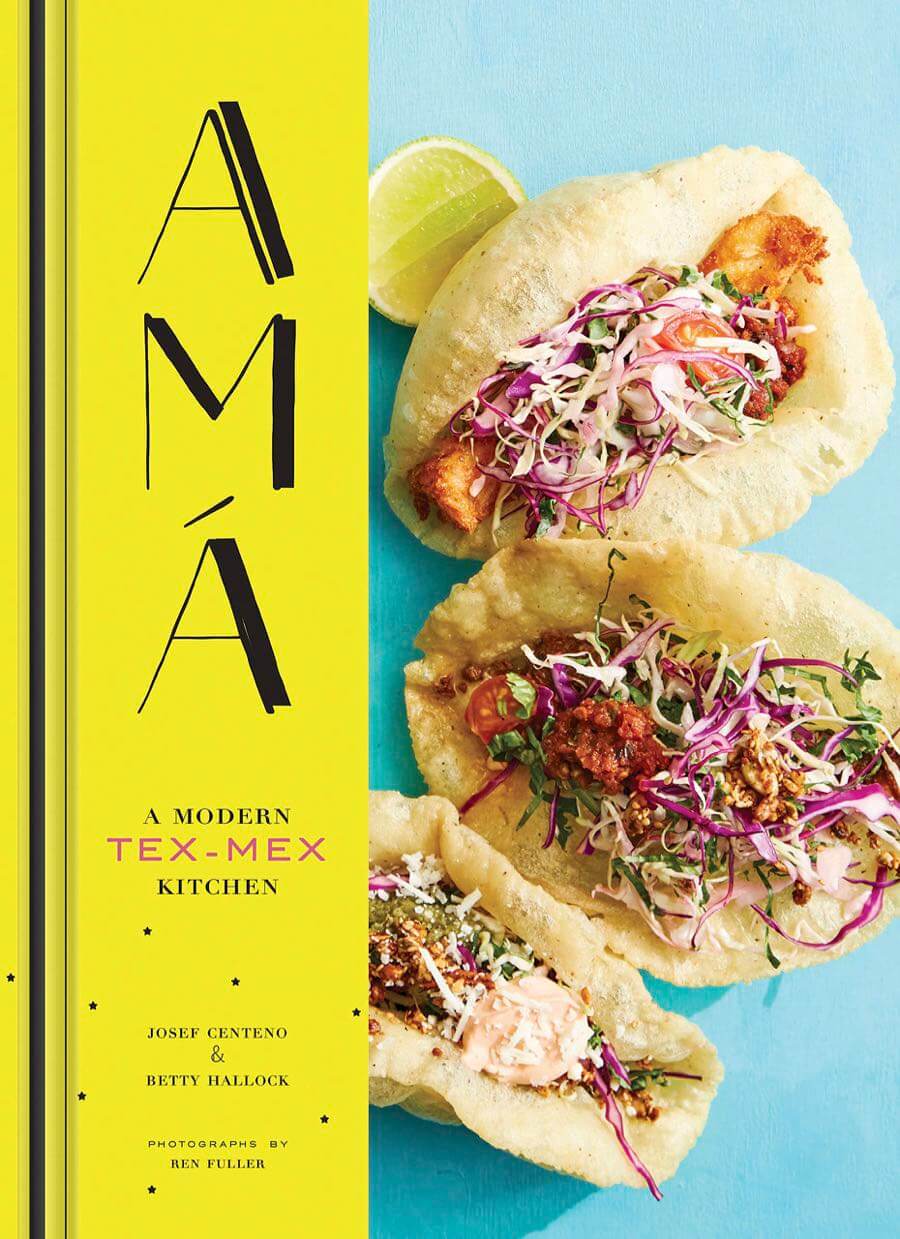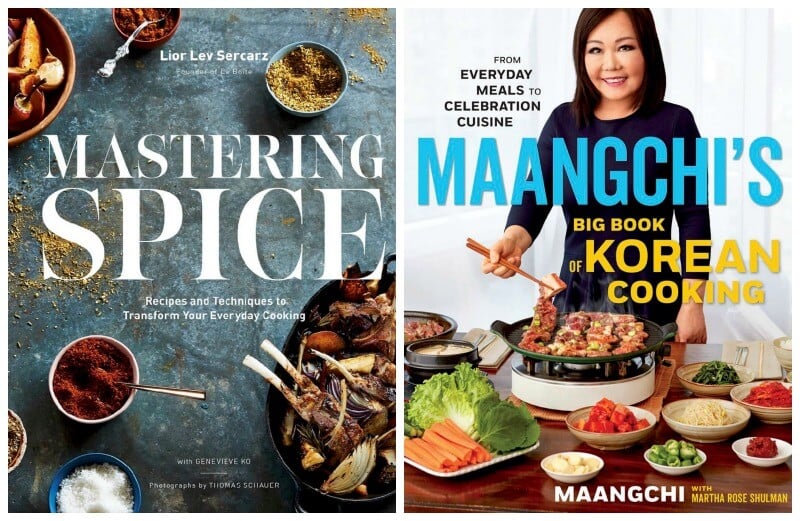5 “Spicy” New Cookbooks: A Chat with Margaret Roach
This post may contain affiliate links. Please read my disclosure policy.
Earlier this fall, Margaret Roach and I spent some time cruising around the cookbook table at HGS Home Chef and noticed a theme: spice!
And so, for our annual cookbook chat, we’ve narrowed the focus to cookbooks whose recipes and resources will help spice things up in the kitchen. These are the five books we discuss (with the exception of Amá, due to time constraints):
- Sababa by Adeena Sussman
- The Gaijin Cookbook by Ivan Orkin and Chris Yin
- Mastering Spice by Lior Lev Sercarz
- Maangchi’s Big Book of Korean Cooking by Maangchi
- Amá by Josef Centeno and Betty Hallock
Thanks to these new books, I’ve been enjoying: herby tahini sauce with harissa Brussels sprouts, stir-fried udon with cabbage, japchae with mushrooms and scallions, roasted vegetables with fennel and sumac, and tahini blondies with sesame seeds and cardamom.
But just as much as I am enjoying cooking from each of these cookbooks, I am enjoying reading them — the stories in each are captivating. I’ve reviewed each briefly below.
Listen to my chat with A Way to Garden’s Margaret Roach here.
Also: There’s a giveaway! I’m giving away a copy of Maangchi’s Big Book of Korean Cooking. Margaret’s giving away a copy of Mastering Spice. Details below.
UPDATE: Winner is Nancy Schwartz. I have emailed you.
PS: Margaret Roach’s Garden is Magical
PPS: Soup’s On! A Chat with Margaret Roach
Maangchi’s Big Book of Korean Cooking
If you are familiar with Maangchi, you’ve likely watched one of her YouTube videos. But in the intro to Maangchi’s Big Book of Korean Cooking, Maangchi writes that while videos are great for demonstrating technique, they don’t show the larger picture of how recipes fit together to make up a cuisine.
But MBBKC does. It feels encyclopedic, a comprehensive guide to Korean cooking from how to shop and stock a pantry to the recipes themselves, which extend from banchan (small side dishes) to street food to one-bowl meals.
There is even a chapter dedicated to the vegan recipes she learned from a group of nuns while visiting a Buddhist temple in the mountains.
Maangchi is funny, and I love what she says about plating: she’s not into serving a tiny amount of food on a small plate, preferring instead to plate “mountain” style, in which everything is heaped into a large, gently sloping mound, which she says reflects her culture’s most important value: generosity.
I made her recipe for japchae, a dish made with translucent sweet potato starch noodles, lots of vegetables, and meat if you wish. Get the recipe: Vegetarian Japchae
The Gaijin Cookbook
The word “gaijin” means foreigner or outsider but implies “intruder.”
In the intro to The Gaijin Cookbook, written by Ivan Orkin and Chris Ying, Ivan writes: “Even though I’ve lived in Japan for the better part of three decades, speak Japanese fluently, have opened two successful ramen shops in Tokyo, and am raising three half-Japanese kids, I’m still a gaijin. I can’t help it, just like I can’t help being head over heels in love with Japan.”
Ivan loves both the culture and the food of Japan, and with The Gaijin Cookbook, he hopes to dispel the idea that all Japanese food is “precious and high flying stuff.”
He thinks in general Japanese food gets treated with an over-the-top reverence, but notes that “a Japanese life encompasses the same range of situations as an American one. There are busy weeknights and weekends when you feel ambitious, picky kids, special occasions, dreary winters, sweltering summers, picnics, potlucks, parties, and hangovers. And there’s food for every occasion.”
The Gaijin Cookbook is not a manual for making perfect sushi or a comprehensive guide to Japanese food. The recipes extend from mostly simple to more elaborate (homemade dumplings or dan dan noodles or temaki (hand rolls)) but the section I’m loving the most is the chapter about Teishokuya, which Ivan relates to an American diner: cheap, everyday Japanese food in its purest form.
Thanks to the book, I bought a big bag of frozen udon noodles, pictured above, and they are SO nice to have on hand as fresh udon noodles can be difficult to find. I made the stir fried udon with cabbage and loved it, and what I’m loving about the book is that if you have soy sauce, mirin, miso, and sake on hand, you can make so many of the recipes.
Final thought: Throughout the book, Ivan reflects on what he’s learned from the Japanese culture as a whole, such as: care for others, not getting in other’s way, reading the air. I love these little reflections and stories — it’s such a great read.
Amá: A Modern Tex-Mex Kitchen
Amá tells the story of Los Angeles chef, Josef Centeno, who grew up in San Antonio, Texas, but wanted to get away. In the intro he writes he once “turned his back” on Tex-Mex cuisine.
With aspirations to be a chef, a young Josef moves away from home, heading first to NYC and eventually to cities all over the country cooking French, Japanese, and Spanish cuisines in Michelin 3-star kitchens.
But when he finds himself thinking about Tex-Mex, the cuisine of his childhood, he returns to San Antonio. And after he eats all the tacos and queso he can, he discovers this is not the food he’s after either.
He’s searching, he realizes, for the food of his family, of his Amá (his grandmother), of a Tex-Mex cuisine the modern, commercialized version has bastardized.
Josef describes the food he grew up with as “simple cooking that [isn’t] authentically Mexican but not the melted-cheese-topped stuff people usually talk about when describing Tex-Mex.”
Contrary to what many people think, Tex-Mex can be very vegetable forward — the vegetable dishes are not limited to salsa and guacamole — and the influences can be diverse. Tex-Mex, moreover, doesn’t have to be super fatty; it can rely on spices to add flavor, not the deep fryer or heaps of queso and sour cream.
And like any cuisine, Tex-Mex, evolves and adapts.
I have not cooked any of the recipes yet but I’m feeling inspired by the many fresh, bright flavors. On my to-do list: pick up a ton of dried chilies along with Mexican oregano to make the Amá spice mix, a blend that finds its way into many of the recipes.
Sababa
“Sababa” means “everything is cool” or “it’s all good,” and as you flip through Adeena Sussman’s Sababa, this is the feeling you get — from her morning ritual visiting a local market, the Shuk HaCarmel, a place she describes as her “constant companion,” to her trips to world-renowned restaurants serving the best hummus and falafel, Adeena gives you a real glimpse into her dreamy Tel Aviv kitchen.
And with Sababa, she makes all of this food accessible to the home cook. In addition to providing resources for where to buy pantry staples, she gives recipes for homemade versions or alternatives if you can’t buy or make either. For instance, if you can’t find pomegranate molasses, you can make your own in 45 minutes with a bottle of pomegranate juice and honey. And if you can’t find dried Persian limes, you can use lime zest and fresh lime juice.
I made her basic tahini sauce recipe, which is delicious, and I made one of the variants by puréeing it with a ton of parsley and cilantro. I topped this herby purée with one of her suggested garnishes, harissa Brussels sprouts, which also were delicious. The combination as a whole with the many variations is something I foresee re-visiting often.
Sababa is not a comprehensive guide to Israeli food, but rather a window into how Adeena cooks right now. She uses a lot of fresh produce, a lot of acidity, and a lot of herbs, spices, and toasted nuts — I love this style of cooking.

Tahini blondies from Sababa.
Mastering Spice
Mastering Spice is much more than a book about blending spices and learning about which spices go with which foods: it’s about cooking techniques that incorporate spice, and it’s about building off these basic techniques to transform everyday cooking.
Lior writes: “Rather than swap methods for roasting vegetables or simmering beans, I simply switch the seasonings. This is a great way to learn how to cook: mastering basic techniques makes it easier to master new seasonings.”
For example, a creamy carrot soup can be flavored with smoked paprika and cumin or basil and oregano or turmeric and lime. This same creamy carrot soup, incidentally, can be used to sauce pasta, a dish Lior garnishes with poppy seeds, which looks/sounds divine.
Mastering Spice is not a vegetarian cookbook, but there is a focus on non-meat dishes, because that’s mostly how Lior cooks these days.
I’m inspired by his use of spice in unexpected ways. For instant, he uses curry spices in dessert and cinnamon on meat. He writes: “No one spice or blend belongs to one culture or place: ras-el-hanout tastes amazing in a strawberry salad.”
This post may contain affiliate links. Please read my disclosure policy.

















186 Comments on “5 “Spicy” New Cookbooks: A Chat with Margaret Roach”
For me is about the one I crave….I would like to have a dish with gochujang sauce (vegan if possible) but I haven’t been able to find a really good gluten free version of the sauce
P.S: love you IG stories!
Gai Pad Krapow
Would love to perfect kimchi recipe that includes more crisp vegetables.
I am comfortable, now, with Creole and Cajun cooking. It is very French, in the way one layers flavor by taking many steps. Gumbo. But Jambalaya in particular. I make my own seasoning mixture. Learned how to really cook with cayenne.
Would like to learn more about Szchuan.
I’d love to be more comfortable pairing spices in my every day cooking 😍
I would have to say my own chili recipe which has evolved over the years. It has the perfect blend of spicy and textures 🙂
It took me a while to get it perfect but punjabi style chickpeas (chole) with homemade masala is the spicy dish I’ve mastered! From Anita’s mad tea party blog
I use a lot of spices when I cook, but would like to experiment with spices I haven’t tried using before, like ones used in different kinds of Asian cooking.
I’m confident in making coconut chicken curry! I add more spice to it than any recipe I’ve found though. I love spicy and would love to learn more 😍
Have nailed down a great instant pot Tiki Masala
Would like to work on a Tom Yum soup recipe for these cold winter days!
There is this dish I had in the Boston area, it was called Suan la chow shua. It was hot, peanutbutter, soy sauce, and so tasty. I tried making it many times but never came close. Its won tons on bean sprouts. The sprouts get really spicy and yummy…so so good.
I would like to cook with spices so that we can eat flavorful food that is not spicy hot–just warm and rich. I love your website.
I would love to make spicy Indian dishes!!!
I crave Indian…we always get the Malai kofta (vegetable dumplings in a rich tomato-nut sauce) and I wish I knew how to make them, because they are fan favorites even for meatatarians. Reminds me a bit of peanut soup, but with quenelle like dumplings that are both tender and utterly satisfying…
My husband would like me to master a spicy drunken noodle. I don’t know that there is one that I’ve mastered yet.
I love making Indian food! I love Chana Masala!
I’ve been a fan of Maangchi for quite some time now. And, yes, she’s so funny that you’ll enjoy watching her all throughout her vids. Not only that, her videos are very comprehensive. Anyway, if there’s one spicy food I’m confident with, it would be CALDERETA. It’s a Filipino dish where you’d cook any protein (beef, chicken, or pork) you like in rich coconut milk and cream until it renders fat and become thick. On the other hand, I want to learn how to cook a nice BIRYANI. My husband likes it since he worked in Middle East before, but I’m not confident of making it at home.
Being from Louisiana I tend to overspice most things ha! When I’m cooking Cajun food, I use Paul Prudhomme’s advice and always use black pepper, white pepper, and cayenne because they all hit the tongue differently and really round out the spice factor.
I wouldn’t say confident, but am more likely to attempt simple curries or salsas. In terms of craving to learn, I am drawn to the warm, rich spices of Indian cuisine and the complex broths of various Asian soups and stews.
I would love to make good tteokboki at home!
I’d like to be more comfortable making mildly spicy food, especially Indian. I tend to either do not enough or way too much spice…
I feel confident in my ability to cook Thai influenced dishes. However, I’d love to master Indian and Korean cuisines— and to use spices in unexpected ways!
There one recipe I am confident in making the most is korean army base stew. Maangchi is like a korean mother to be even though I am India. The stew always turns out a little bit to spicy for everyone else but it just seems right for me as I feel kimchi is in my blood. I will definitely have to try out the japchae recipe in that method as it does seems a 100x easier than her youtube video. Thank you!
I love spicy food. The one I really would like to learn to cook at home is a thai pumpkin curry. It is one of my husband’s and my favorite!
The spicy recipe I am confident making is the Chana Masala recipe from the Good and Cheap cookbook, because the ingredients are easy to find, and I’ve made it so many times (try putting cream too yogurt on top, yum!) I would like to learn how to cook an authentic Sichuan Chinese dish – maybe Spicy Stir Fried Chicken?
(Also, love your recipes and also your IG stories!)
Oops! I meant cream *top* yogurt!!
Have yet to master chicken tikka masala – my white whale! But I can whip up an Asian stir fry with what’s left in my fridge!
So simple, but I wish I could master a good yellow curry. Everytime I make it myself it turns out just a ~tiny bit off and I wish I could get the perfect amount of spice for my liking.
I don’t have a mastered spicy recipe but I love making kimchi stew whenever the weather gets colder!
I make a spicy cilantro pesto with roasted Jalapeno peppers and lime juice. Its great with rigatoni noodles and garnished with aged Gouda.
I crave spicy Pad Thai! One thing I make that is spicy is Dragon Noodles. My son loves it!
I bake a salmon filet rubbed with smoky chili pepper and brown sugar, the blend of sweet and spicy is delicious. I don’t measure anything…it always comes out tasty.